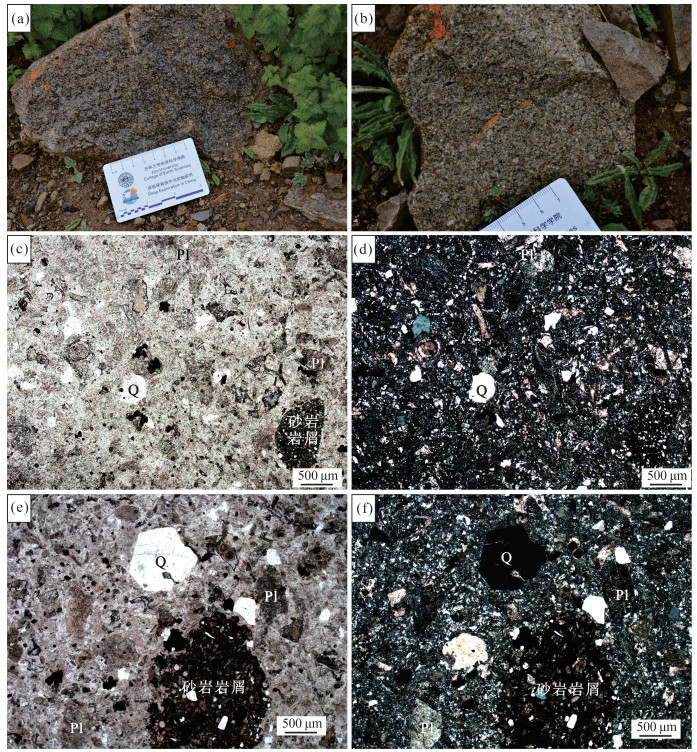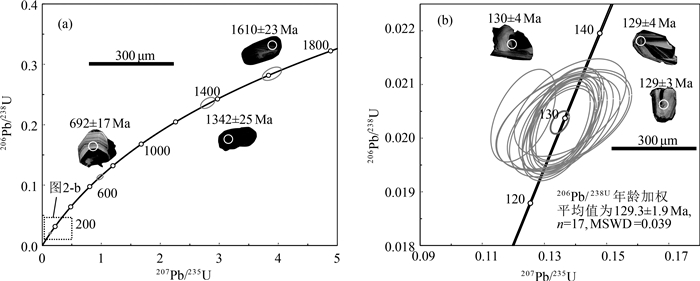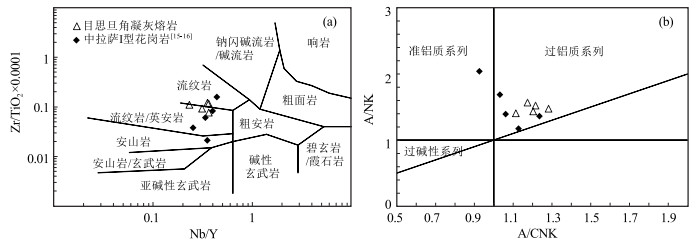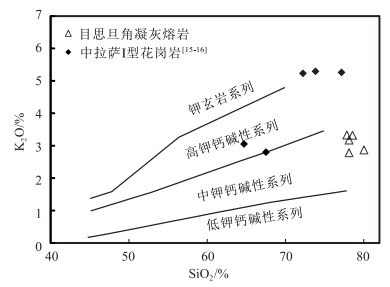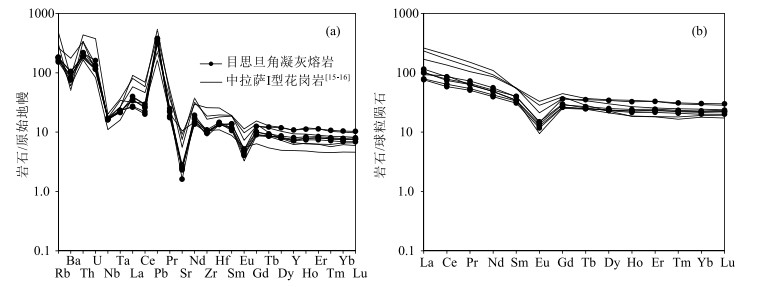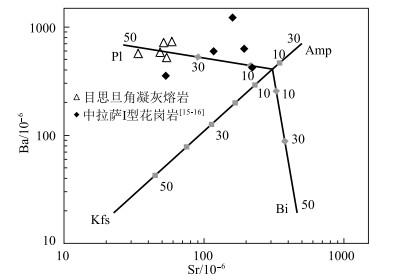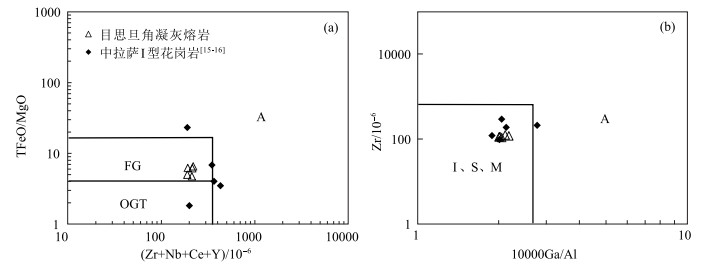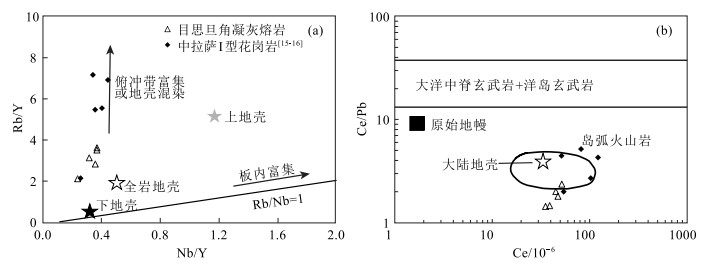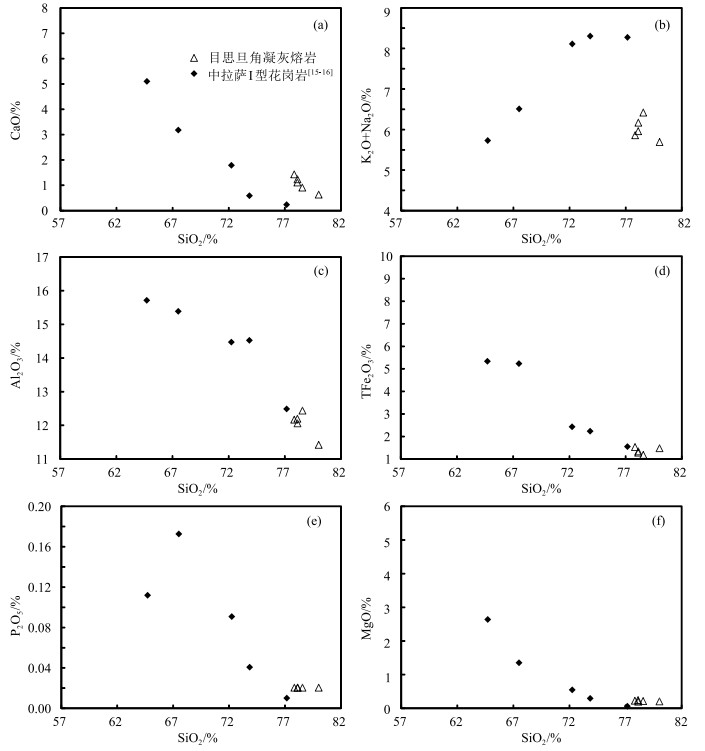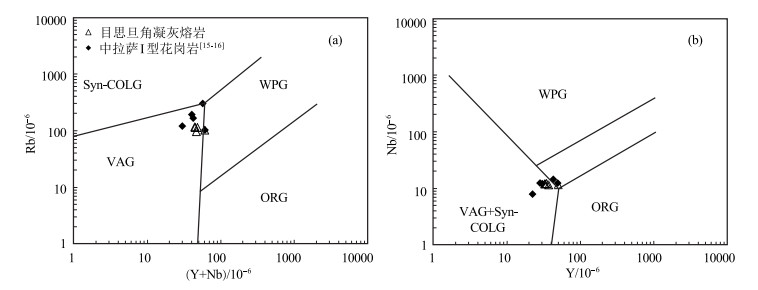Geochronology, magmatic genesis and tectonic setting of the Musidanjiao tufflava in the Asa area, Xizang
-
摘要:
为了进一步探讨西藏中部阿索地区的白垩纪岩浆活动演化历史,于阿索南部的目思旦角附近采集了一期早白垩世流纹质岩屑晶屑凝灰熔岩样品,对其进行了年代学及全岩地球化学测试。测得目思旦角凝灰熔岩中锆石206Pb/238U年龄加权平均值为129.3±1.9 Ma(n=17,MSWD=0.039)。地球化学测试结果表明,凝灰熔岩具有极高的SiO2(76.27%~78.70%)含量,中等的Al2O3(11.23%~12.21%)及全碱(5.60%~6.30%)含量,很低的全铁(1.16~1.50%)、CaO(0.62%~1.40%)、MgO(0.19%~0.24%)、TiO2(0.09%~0.15%)和P2O5(0.02%~0.02%)含量;且它们表现出富集U、Th、Pb等大离子亲石元素,亏损Nb、Ta、Ti等高场强元素,并具有富集的轻稀土元素,平缓的重稀土元素,以及明显的负Eu异常。这些特征与陆缘弧地区发育的典型I型花岗质岩石的地球化学属性相似,指示它们的源区可能为部分熔融的中地壳,并在后期经历了显著的结晶分异作用。结合阿索地区已报道的120 Ma左右的陆缘岛弧岩浆活动,以及105 Ma左右的伸展型岩浆活动,认为阿索地区130 Ma左右的早白垩世流纹质岩屑晶屑凝灰熔岩可能形成于班公湖-怒江洋南向俯冲的构造背景。
-
关键词:
- 西藏阿索 /
- 凝灰熔岩 /
- 班公湖-怒江洋 /
- LA-ICP-MS锆石U-Pb定年
Abstract:In order to further explore the evolution history of Cretaceous magmatism in the Asa area, central Xizang, samples were collected from Early Cretaceous rhyolitic tufflava near Musidanjiao, south of the Asa area, to carry out the geochronological and geochemical studies.The mean zircon 206Pb/238U age of Musidanjiao tufflava yields 129.3±1.9 Ma(n=17, mswd=0.039).The geochemical test results show that the tufflava has extremely high SiO2 content(76.27%~78.70%), moderate Al2O3(11.23~12.21%), total alkali content of 5.60%~6.30%, very low total iron(1.16%~1.50%), CaO(0.62%~1.40%), MgO(0.19%~0.24%), TiO2(0.09%~0.15%), and P2O5(0.02%~0.02%) contents.Moreover, they show enrichment of large ion lithophile elements such as U, Th and Pb, and depletion of high field strength elements such as Nb, Ta and Ti, as well as enrichment of LREE, flat HREE and obvious negative Eu anomaly.These characteristics indicate that they might be originated from the partial melting of middle crust and experienced significant crystallization differentiation in the later period, which is geochemically similar to the typical Ⅰ-type granitoids developed in the continental margin arc region.In combination with the reported continental margin island arc magmatism of~120 Ma and the extensional magmatism of~105 Ma in the Asa area, it is suggested that the Early Cretaceous rhyolitic taffflava magmatism of~130 Ma in the Asa area might be formed in the background of the southward subduction of Bangong-Nujiang Ocean.
-
Key words:
- Asa, Xizang /
- tufflava /
- Bangong-Nujiang Ocean /
- LA-ICP-MS zircon U-Pb dating
-

-
图 4 目思旦角凝灰熔岩SiO2-K2O图解[35]
Figure 4.
图 5 阿索目思旦角凝灰熔岩原始地幔标准化微量元素蛛网图(a)及球粒陨石标准化稀土元素配分曲线(b)(标准化数据据参考文献[36])
Figure 5.
图 6 目思旦角凝灰熔岩Sr-Ba图解[37]
Figure 6.
图 8 Nb/Y-Rb/Y(a)和Ce-Ce/Pb(b)图解(底图据参考文献[40])
Figure 8.
图 10 花岗质岩石构造判别图解[50]
Figure 10.
表 1 目思旦角凝灰熔岩锆石U-Th-Pb同位素测试结果
Table 1. Zircon U-Th-Pb isotopic results of the tafflava in the Musidanjiao area
样品号 Th U Th/U 同位素比值 年龄/Ma 10-6 207Pb/206Pb 1σ 207Pb/235U 1σ 206Pb/238U 1σ 207Pb/206Pb 1σ 207Pb/235U 1σ 206Pb/238U 1σ N18T24-01 225.23 163.29 1.38 0.04858 0.00281 0.13480 0.00787 0.02012 0.00057 128 82 128 7 128 4 N18T24-02 162.70 186.65 0.87 0.04863 0.00277 0.13459 0.00773 0.02007 0.00057 130 80 128 7 128 4 N18T24-03 55.68 60.26 0.92 0.09924 0.00234 3.89205 0.10789 0.28442 0.00729 1610 23 1612 22 1614 37 N18T24-04 49.74 58.11 0.86 0.06269 0.00217 0.98030 0.03628 0.11340 0.00300 698 38 694 19 692 17 N18T24-05 98.22 164.31 0.60 0.04866 0.00255 0.13657 0.00730 0.02035 0.00056 131 74 130 7 130 4 N18T24-06 203.23 381.06 0.53 0.04864 0.00199 0.13593 0.00581 0.02027 0.00054 131 53 129 5 129 3 N18T24-07 209.48 173.34 1.21 0.04866 0.00244 0.13559 0.00692 0.02021 0.00056 131 69 129 6 129 4 N18T24-08 162.93 68.03 2.39 0.08617 0.00212 2.80527 0.08012 0.23611 0.00608 1342 25 1357 21 1366 32 N18T24-09 123.64 156.61 0.79 0.04871 0.00273 0.13734 0.00781 0.02045 0.00057 134 80 131 7 130 4 N18T24-10 430.89 367.56 1.17 0.04868 0.00231 0.13604 0.00661 0.02027 0.00056 132 64 130 6 129 4 N18T24-11 152.43 155.03 0.98 0.04858 0.00304 0.13564 0.00846 0.02025 0.00061 128 87 129 8 129 4 N18T24-12 561.22 189.79 2.96 0.04851 0.00398 0.13545 0.01102 0.02025 0.00064 124 124 129 10 129 4 N18T24-13 395.75 280.90 1.41 0.04865 0.00333 0.13597 0.00939 0.02027 0.00058 131 103 129 8 129 4 N18T24-14 213.49 216.95 0.98 0.04877 0.00418 0.13830 0.01188 0.02057 0.00060 137 138 132 11 131 4 N18T24-15 95.15 105.81 0.90 0.04846 0.00505 0.13584 0.01417 0.02033 0.00060 122 178 129 13 130 4 N18T24-16 155.57 168.78 0.92 0.04861 0.00271 0.13573 0.00765 0.02025 0.00058 129 78 129 7 129 4 N18T24-17 99.11 175.82 0.56 0.04875 0.00426 0.13618 0.01196 0.02026 0.00058 136 143 130 11 129 4 N18T24-18 139.47 177.64 0.79 0.04852 0.00267 0.13676 0.00762 0.02044 0.00058 125 77 130 7 130 4 N18T24-19 117.77 117.44 1.00 0.04861 0.00512 0.13636 0.01434 0.02034 0.00062 129 178 130 13 130 4 N18T24-20 41.52 156.85 0.26 0.04374 0.00240 0.12318 0.00688 0.02042 0.00057 -84 71 118 6 130 4 表 2 目思旦角凝灰熔岩全岩主量、微量和稀土元素含量
Table 2. Whole-rock major, trace elements and REE contents of the tafflava in the Musidanjiao area
元素 T24H1 T24H2 T24H3 NT24H4 T24H5 元素 T24H1 T24H2 T24H3 NT24H4 T24H5 SiO2 77.13 76.72 78.70 76.27 76.81 Ce 39.3 35.7 47.8 45.4 52.4 Al2O3 12.21 11.84 11.23 11.92 11.99 Pr 5.15 4.83 6.25 6.03 6.89 TFe2O3 1.16 1.31 1.45 1.50 1.26 Nd 19.7 18.4 23.8 22.6 26.1 CaO 0.89 1.21 0.62 1.40 1.09 Sm 5.13 4.73 6.13 5.24 6.02 MgO 0.21 0.19 0.20 0.22 0.24 Eu 0.73 0.68 0.85 0.79 0.87 K2O 3.26 2.73 2.82 3.26 3.12 Gd 5.45 5.37 7.45 5.91 6.09 Na2O 3.04 3.33 2.78 2.48 2.74 Tb 0.93 0.92 1.32 1.01 0.95 TiO2 0.09 0.09 0.10 0.13 0.15 Dy 5.95 6.01 8.68 6.35 5.86 P2O5 0.02 0.02 0.02 0.02 0.02 Ho 1.28 1.28 1.84 1.36 1.22 MnO 0.03 0.03 0.04 0.04 0.04 Er 3.80 3.89 5.44 4.03 3.56 烧失量 1.90 2.16 1.84 2.39 2.11 Tm 0.58 0.56 0.79 0.59 0.53 Cr 4.38 4.19 3.72 4.33 4.58 Yb 3.76 3.67 5.15 3.86 3.40 Ni 1.26 1.49 1.69 1.69 1.66 Lu 0.56 0.56 0.76 0.60 0.51 Ga 13.5 12.8 12.2 13.6 14.1 Hf 4.17 4.35 4.18 4.51 4.17 Rb 115 96.4 103 114 117 Ta 0.95 0.95 0.92 0.91 0.88 Sr 51.6 54.2 33.9 59.0 48.6 Pb 26.8 24.7 26.4 22.7 22.2 Y 32.9 34.4 49.4 36.8 32.6 Th 16.4 16.0 18.2 15.9 18.6 Zr 107 111 112 122 117 U 2.76 2.46 3.37 2.40 2.81 Nb 12.0 12.2 11.5 11.5 11.9 Mg# 29.7 25.3 24.3 25.5 30.7 Ba 722 526 572 737 585 Eu/Eu* 0.42 0.41 0.38 0.44 0.44 La 18.7 18.1 23.5 24.4 27.3 注:主量元素含量单位为%,微量和稀土元素含量单位为10-6 -
[1] Dewey J F, Shackelton R M, Chang C F, et al. The tectonic evolution of the Xizang Plateau[J]. Philos. Trans. R. Soc. Lond. A., 1988, 327: 379-413. doi: 10.1098/rsta.1988.0135
[2] Suess E. Are great oceans depths permanent?[J]Nat. Sci., 1893, 2: 180-187.
[3] Şengör A M C, Yilmaz Y. Tethyan evolution of Turkey: a plate tectonic approach[J]. Tectonophysics, 1981, 75: 181-241. doi: 10.1016/0040-1951(81)90275-4
[4] Metcalfe I. Gondwana dispersion and Asian accretion: Tectonic and palaeogeographic evolution of eastern Tethys[J]. Journal of Asian Earth Sciences, 2013, 66: 1-33. doi: 10.1016/j.jseaes.2012.12.020
[5] Pan G T, Wang L Q, Li R S, et al. Tectonic evolution of the Qinghai-Xizang Plateau[J]. Journal of Asian Earth Science, 2012, 53(2): 3-14.
[6] Zhu D C, Zhao Z D, Niu Y, et al. The origin and pre-Cenozoic evolution of the Xizang Plateau[J]. Gondwana Research, 2013, 23(4): 1429-1454. doi: 10.1016/j.gr.2012.02.002
[7] Zhu D C, Zhao Z D, Niu Y, et al. Lhasa terrane in southern Xizang came from Australia[J]. Geology, 2011, 39(8): 727-730. doi: 10.1130/G31895.1
[8] Luo A B, Wang M, Li C, et al. Petrogenesis of early Late Cretaceous Asa-intrusive rocks in central Xizang, western China: post-collisional partial melting of thickened lower crust[J]. International Journal of Earth Sciences, 2019, 108(6): 1979-1999. doi: 10.1007/s00531-019-01744-4
[9] Liu D L, Shi M, Jiang S Y. Dating oceanic subduction in the Jurassic Bangong-Nujiang oceanic arc: a zircon U-Pb age and Lu-Hf isotopes and Al-in-Hornblende barometry study of the Lameila pluton in western Xizang, China[J]. Minerals, 2019, 9(12): 754. doi: 10.3390/min9120754
[10] Li H, Wang M, Zeng X W, et al. Slab break-off origin of 105 Ma A-type porphyritic granites in the Asa area of Xizang[J]. Geological Magazine, 2020, 157(8): 1-18.
[11] 王嘉星, 刘治博, 李海峰, 等. 西藏班公湖-怒江结合带中段早白垩世花岗闪长斑岩年龄, Hf同位素及地球化学特征[J]. 地质通报, 2020, 39(5): 608-620. http://dzhtb.cgs.cn/gbc/ch/reader/view_abstract.aspx?file_no=20200502&flag=1
[12] 刘治博, 李海峰, 高轲, 等. 西藏班公湖-怒江缝合带中段去申拉组火山岩锆石U-Pb年龄及Hf同位素特征[J]. 地质通报, 2019, 38(6): 1018-1027. http://dzhtb.cgs.cn/gbc/ch/reader/view_abstract.aspx?file_no=20190612&flag=1
[13] Gutscher M A, Malod J, Rehault J P, et al. Evidence for active subduction beneath gibraltar[J]. Geology, 2003, 30(12): 1071-1074.
[14] Yin A, Harrison T M. Geologic Evolution of the Himalayan-Xizang Orogen[J]. Annual Review of Earth and Planetary Sciences, 2000, 28(1): 211-280. doi: 10.1146/annurev.earth.28.1.211
[15] Zhu D C, Zhao Z D, Niu Y, et al. The Lhasa Terrane: Record of a microcontinent and its histories of drift and growth[J]. Earth and Planetary Science Letters, 2011, 301(1/2): 241-255. http://www.sciencedirect.com/science/article/pii/S0012821X10007004
[16] Zhu D C, Mo X X, Niu Y, et al. Geochemical investigation of Early Cretaceous igneous rocks along an east-west traverse throughout the central Lhasa Terrane, Xizang[J]. Chemical Geology, 2009, 268(3/4): 298-312. http://www.sciencedirect.com/science/article/pii/S0009254109003878
[17] Qu X M, Wang R J, Xin H B, et al. Age and petrogenesis of A-type granites in the middle segment of the Bangonghu-Nujiang suture, Xizang plateau[J]. Lithos, 2012, 146/147: 264-275. doi: 10.1016/j.lithos.2012.05.006
[18] Chen Y, Zhu D C, Zhao Z D, et al. Slab breakoff triggered ca. 113Ma magmatism around Xainza area of the Lhasa Terrane, Xizang[J]. Gondwana Research, 2014, 26(2): 449-463. doi: 10.1016/j.gr.2013.06.005
[19] 张晓倩, 朱弟成, 赵志丹, 等. 西藏措勤尼雄岩体的岩石成因及其对富Fe成矿作用的潜在意义[J]. 岩石学报, 2010, 26(6): 1793-1804. https://www.cnki.com.cn/Article/CJFDTOTAL-YSXB201006014.htm
[20] 吴浩, 李才, 胡培远, 等. 藏北班公湖-怒江缝合带早白垩世双峰式火山岩的确定及其地质意义[J]. 地质通报, 2014, 33(11): 1804-1814. doi: 10.3969/j.issn.1671-2552.2014.11.016 http://dzhtb.cgs.cn/gbc/ch/reader/view_abstract.aspx?file_no=20141116&flag=1
[21] Wu H, Li C, Xu M, et al. Early Cretaceous adakitic magmatism in the Dachagou area, northern Lhasa terrane, Xizang: Implications for slab roll-back and subsequent slab break-off of the lithosphere of the Bangong-Nujiang Ocean[J]. Journal of Asian Earth Sciences, 2015, 97: 51-66. doi: 10.1016/j.jseaes.2014.10.014
[22] Wu H, Li C, Hu P Y, et al. Early Cretaceous(100-105 Ma) Adakitic magmatism in the Dachagou area, northern Lhasa terrane, Xizang: Implications for the Bangong-Nujiang Ocean subduction and slab break-off[J]. International Geology Review, 2014, 57(9/10): 1172-1188.
[23] Sui Q L, Wang Q, Zhu D C, et al. Compositional diversity of ca. 110 ma magmatism in the northern lhasa terrane, Xizang: implications for the magmatic origin and crustal growth in a continent-continent collision zone[J]. Lithos, 2013, 168: 144-159.
[24] 康志强, 许继峰, 董彦辉, 等. 拉萨地块中北部白垩纪则弄群火山岩: Slainajap洋南向俯冲的产物?[J]. 岩石学报, 2008, 2: 303-314. https://www.cnki.com.cn/Article/CJFDTOTAL-YSXB200802012.htm
[25] Zhang L L, Zhu D C, Zhao Z D, et al. Early granitoids in Xainza, Xizang: evidence of slab break-off[J]. Acta Petrologica Sinica, 2011, 27: 1938-1948.
[26] Liu D L, Huang Q S, Fan S Y, et al. Subduction of the bangong-nujiang ocean: constraints from granites in the bangong co area, Xizang[J]. Geological Journal, 2014, 49: 188-206. doi: 10.1002/gj.2510
[27] 解龙, 顿都, 朱利东, 等. 西藏北冈底斯扎独顶A型花岗岩锆石U-Pb年代学、地球化学及其地质意义[J]. 中国地质, 2015, (5): 1214-1227. doi: 10.3969/j.issn.1000-3657.2015.05.004
[28] Li Y, He H, Wang C, et al. Early Cretaceous(ca. 100 Ma) magmatism in the southern Qiangtang subterrane, central Xizang: Product of slab break-off[J]? International Journal of Earth Science, 2016, 106(4): 1289-1310.
[29] Yang Z Y, Wan Q, Zhang C, et al. Rare earth element tetrad effect and negative Ce anomalies of the granite porphyries in southern Qiangtang Terrane, central Xizang: New insights into the genesis of highly evolved granites[J]. Lithos, 2018, 312/313: 258-273. doi: 10.1016/j.lithos.2018.04.018
[30] Anderson T. Correction of common lead in U-Pb analyses that do not report 204 Pb[J]. Chemical Geology, 2002, 192(1/2): 59-79. http://www.sciencedirect.com/science/article/pii/S000925410200195X
[31] Hao Y J, Ren Y S, Zhao H L, et al. Metallogenic mechanism and tectonic setting of tungsten mineralization in the yangbishan deposit in northeastern china[J]. Acta Geologica Sinica, 2018, 92: 241-267. doi: 10.1111/1755-6724.13504
[32] 李文庆. 硼酸盐熔融制样法测定辉绿岩中10种常量元素的准确度[J]. 世界地质, 2019, 38(3): 843-851. https://www.cnki.com.cn/Article/CJFDTOTAL-SJDZ201903029.htm
[33] Winchester J A, Floyd P A. Geochemical discrimination of different magma series and their differentiation products using immobile elements[J]. Chemical Geology, 1977, 20: 325-343. doi: 10.1016/0009-2541(77)90057-2
[34] Maniar P D, Piccoli P M. Tectonic discrimination of granitoids[J]. Geological Society of America Bulletin, 1989, 101: 635-643. doi: 10.1130/0016-7606(1989)101<0635:TDOG>2.3.CO;2
[35] Middlemost E A K. Magmas and Magmatic Rocks. An Introduction to Igneous Petrology[M]. London: Longman, 1986: 1-26.
[36] Sun S S, McDonough W F. Chemical and isotopic systematics of oceanic basalts: implications for mantle composition and processes[J]. Geological Society, London, Special Publications, 1989, 42(1): 313-345. doi: 10.1144/GSL.SP.1989.042.01.19
[37] Janoušek V, Finger F, Roberts M, et al. Deciphering the petrogenesis of deeply buried granites: whole-rock geochemical constraints on the origin of largely undepleted felsic granulites from the Moldanubian Zone of the Bohemian Massif. Transactions of the Royal Society of Edinburgh[J]. Earth Sciences. 2007, 95(1/2): 141-159
[38] Whalen J B, Currie K L, Chappell B W. A-type granites: geochemical characteristics, discrimination and petrogenesis[J]. Contributions to Mineralogy and Petrology, 1987, 95(4): 407-419. doi: 10.1007/BF00402202
[39] 李斌, 刘淼, 陈井胜, 等. 内蒙古赤峰敖汉地区酸性火山岩的形成时代、地球化学特征及其意义[J]. 地球科学, 2019, 44(10): 3378-3392. https://www.cnki.com.cn/Article/CJFDTOTAL-DQKX201910015.htm
[40] Boztuĝ D, Harlavan Y, Arehart G, et al. K-Ar age, whole-rock and isotope geochemistry of A-type granitoids in the Divriĝi-Sivas region, eastern-central Anatolia, Turkey[J]. Lithos, 2007, 97: 193-218. doi: 10.1016/j.lithos.2006.12.014
[41] 王德滋, 周金城, 邱检生, 等. 中国东南部晚中生代花岗质火山-侵入杂岩特征与成因[J]. 高校地质学报, 2000, 6: 487-498. doi: 10.3969/j.issn.1006-7493.2000.04.001
[42] Zhu D C, Li S M, Cawood P A, et al. Assembly of the Lhasa and Qiangtang terranes in central Xizang by divergent double subduction[J]. Lithos, 2016, 245: 7-17. doi: 10.1016/j.lithos.2015.06.023
[43] Coulon C, Maluski H, Bollinger C, et al. Mesozoic and cenozoic volcanic rocks from central and southern Xizang: 39Ar-40Ar dating, petrological characteristics and geodynamical significance[J]. Earth and Planetary Science Letters, 1986, 79(3/4): 281-302.
[44] Ding L, Lai Q Z. New geological evidence of crustal thickening in the gangdese block prior to the indo-asian collision[J]. Chinese Science Bulletin, 2003, 15: 1604-1610.
[45] Zhang K J, Xia B D, Wang G M, et al. Early Cretaceous stratigraphy, depositional environments, sandstone provenance, and tectonic setting of central Xizang, western China[J]. Geological Society of America Bulletin, 2004, 116(9): 1202-1222. doi: 10.1130/B25388.1
[46] Zhang K J, Zhang Y X, Tang X C, et al. Late Mesozoic tectonic evolution and growth of the Xizang plateau prior to the Indo-Asian collision[J]. Earth Science Reviews, 2012, 114(3/4): 236-249.
[47] Kapp P, Yin A, Harrison T M, et al. Cretaceous-Tertiary shortening, basin development, and volcanism in central Xizang[J]. Geological Society of America Bulletin, 2005, 117(7): 865-878. doi: 10.1130/B25595.1
[48] Wang W, Wang M, Zhai Q G, et al. Transition from oceanic subduction to continental collision recorded in the Bangong-Nujiang suture zone: Insights from Early Cretaceous magmatic rocks in the north-central Xizang[J]. Gondwana Research, 2020, 78: 77-91. doi: 10.1016/j.gr.2019.09.008
[49] 曾孝文, 王明, 范建军, 等. 藏北阿索地区早白垩世基性岩脉地球化学及年代学特征: 对班公湖-怒江洋闭合时限的约束[J]. 地球科学, 2019, 44(7): 2408-2425. https://www.cnki.com.cn/Article/CJFDTOTAL-DQKX201907016.htm
[50] Pearce J A, Harris N B W, TIndle A G. Trace element discrimination diagrams for the tectonic interpretation of granitic rocks[J]. Journal of Petrology, 1984, 25: 956-983. doi: 10.1093/petrology/25.4.956
-



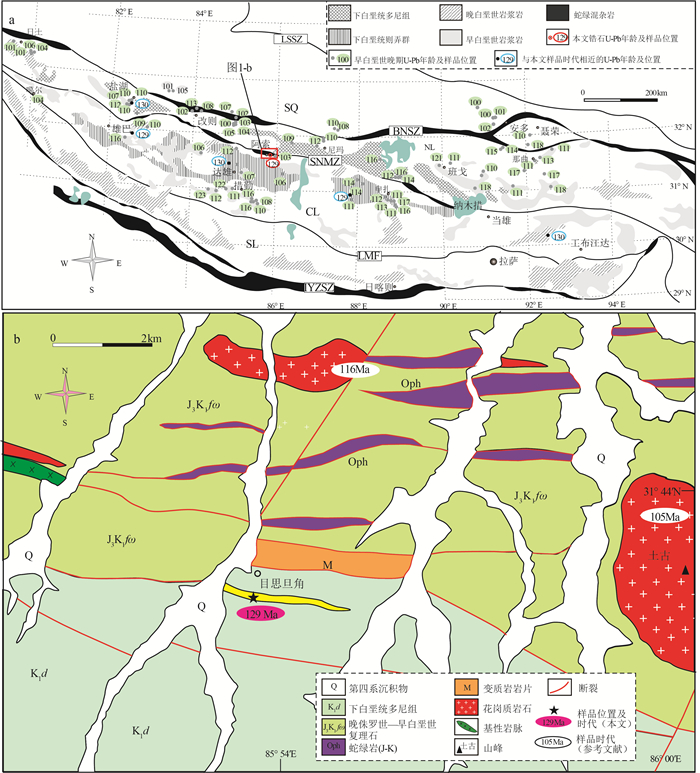
 下载:
下载:
